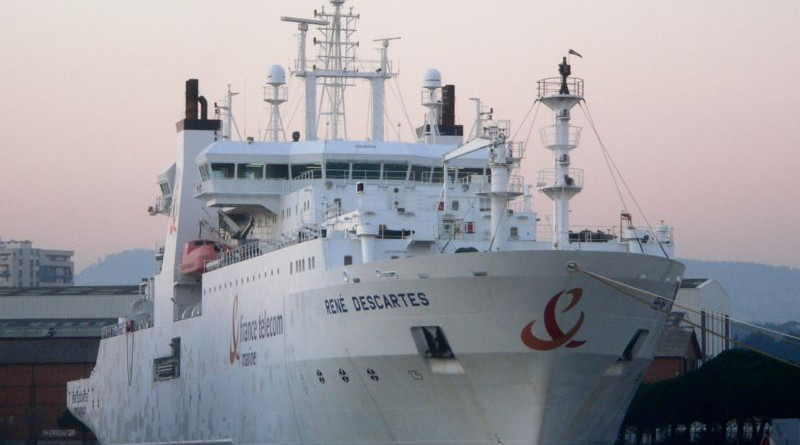Threat To The World’s Communication Lifeline – Analysis
Our interconnected world can be shut down fairly easily by severing fiber-optic lines on land or at sea. Over the past decade or two there have been constant attempts to break these telecommunications lines, either as simple vandalism or as a way to interfere in connectivity in a world increasingly focused on accelerating geopolitical change.
Interestingly, despite advanced Wi-Fi and cloud systems, all data still travels by fiber-optic cables, which are actually state-of-the-art global communications technology.
There is a long history of cutting cables, so examples now are part of the evolution of attempts to break communications, whether by a lone wolf or state actor. Surveillance technologies are keeping pace with attacks on land, but in the maritime environment the story is different. Robotics is helping to improve sabotage capabilities as the technology evolves. Clearly, maritime missions are going to require greater surveillance capacity of fiber-optic cables.
To be sure, these types of attacks are not new. In 2010, in San Jose, California, an individual chainsawed a fiber-optic cable critical to a vast communications network for Santa Clara, Santa Cruz and San Benito counties. At that time, the Silicon Valley tech giants recognized the threats to the earlier fiber networks, which rely on an underground network of cables and wires. Since then, tech companies globally have had to think about how to protect these lines, and restore service after sabotage through Network Emergency Response Vehicles — fiber-optic first responders who have expanded to include local government and infrastructure specialists who now dominate crisis management. The response evolution in Silicon Valley should be an example to the rest of the world as it grows its fiber-optic hubs and spokes.
Fast forward to 2021 and Norway’s experience with severed cables is notable. Security analysts were quick to point out that the two Svalbard undersea fiber-optic cables connecting a satellite ground station on Svalbard to the Norwegian mainland were severed as part of a possible “military” attack on a military cable. Some analysts wanted to rule out sabotage by arguing that fishing trawlers routinely cause damage to subsea cables when fishing nets or in some cases anchors drag along the seafloor. But numerous“occurrences” mean that this arena of fiber-optic line security, both prevention and response, is going to require additional attention. With increasing requirements for internet and other communications between different communities and stakeholders, especially in the humanitarian aid sphere, such lines of communication must be stable.
Other cable incidents are meant to instill fear in a populace without communications. This “fear factor” of cutting cables and losing communication is becoming more important in terms of information warfare, so severing fiber-optic lines has an impact on human behavior.
Cutting important cables has also occurred in and around the UK. The SHEFA-2 undersea cable linking the Faroe Islands to mainland Scotland via Shetland and Orkney was damaged in two separate incidents in October 2022 that left much of the islands without internet connection. Also last year, a cable was cut at a major landing point hub for several undersea internet cables, causing a chain reaction of connectivity problems across Europe. Connectivity was especially disrupted on the internet cable between Marseille-Lyon, Marseille-Milan, and Marseille-Barcelona. So the impact range of these severed cables can be felt quite widely across Western Europe. Again, the length of outage differed but resumption of service was within a few days to a week.
The October 2022 cable cut near Aix-en-Provence in France caused a global internet connectivity slowdown. Some analysts believe the cable was severed in a deliberate act of vandalism, others have described it as sabotage. No one was ever held responsible, signaling how these attacks are easy to mask given gaps in coverage of the cable line, even on land. The good news is that repair time for land cuts is only about 48 hours.
Some have suggested that Russia may be behind these sabotage attacks, but there is no evidence to support these claims. That is a common problem. Saboteurs, especially lone wolves, are hard to find, which is increasingly problematic from a security point of view. Already there is increased awareness of foreign threat actors who have the technology and the ability to cut such cables. Combining an undersea snip with a land-based interruption is a likely scenario for the bad guys.
Infrastructure authorities and corporate developers of optic lines are stepping up security for critical land and subsea infrastructure, including those related to key industries. Some operators are working with the fiber-optic industry to develop and deploy drones to watch pipelines and other nodes in fiber-optic networks. The growth of new lines in the maritime environment, especially the Google Line around West Africa to Europe, various Arabian Peninsula related projects, and other fiber-optic cables from Japan or Taiwan, are vulnerable to state-level sabotage.

